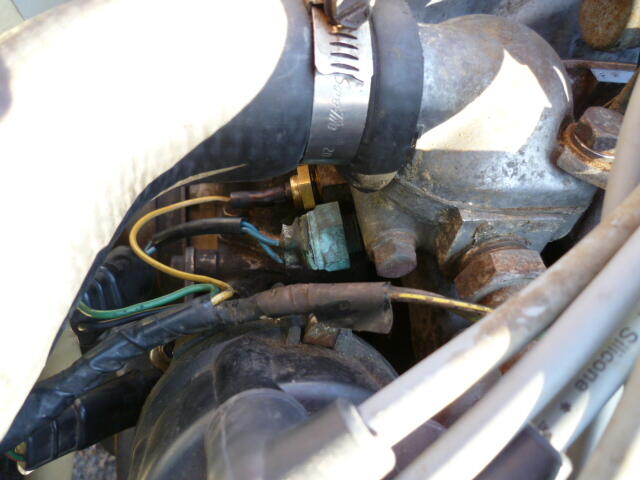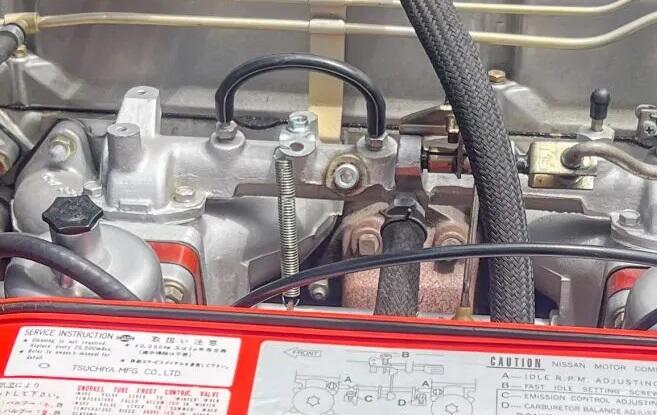Everything posted by Captain Obvious
- Is anyone there?
-
Sealing an oil pan
Well the reinforcement strips weren't as expensive as that aluminum pan! I'll re-run the numbers when I get the chance. I've never seen one of those pans in person, but if it's stiff enough, a gasket should seal without goop. In thoery.
-
Sealing an oil pan
Oh, and the last time I did an oil pan, I did things a little different. First the same: I bought a cork/rubber combo gasket like Datsun used originally and I used permatex gray (a very tiny bead) on both sides of the gasket. That tiny bead hopefully will not make it very difficult to get the oil pan off again if I ever need to. Hope I never need to, but hoping it won't be a battle if I ever do. After applying the tiny bead, I I torqued the pan into place and let the sealant cure. That much of the process is pretty much what I had done in the past. Then I did something different... After giving the sealant a couple days or so to cure, I went back, and ONE BY ONE, I removed the bolts, put some blue thread lock on them, and torqued them in again. My thinking on this is twofold: First, the gasket had time to compress and take a set. This was confirmed as I was taking the bolts out because some of them were looser than they were when I put them in couple days before. And second... The torque spec on those oil pan bolts is so small that It barely even compresses the lock washer. I'm thinking that maybe not even enough to prevent the bolts from loosening over time. So my theory, which is mine, is that the blue threadlock will keep the bolts torqued (even at such a low amount) while giving the gasket a day to take a compression set before final torque will keep the gasket under pressure. Won't know for a while how successful that whole thing was, but I'm hopeful!
-
Sealing an oil pan
I made up a CAD file for better / longer reinforcement pieces and ran some quotes. The costs were higher than what I was willing to deal with at the time. And that was before covid. If there is interest, I can open that can again and get a fresh quote?
- Is anyone there?
-
rear clunking noise '76 280z
They all are, my friend. They all are. ☺️
-
rear clunking noise '76 280z
Glad to help. And hope your clunk is gone for good!
-
rear clunking noise '76 280z
You can do final torque to the center nut after installation of the strut assy on the car. That way, the three insulator studs are held firm by the car body and you can get a good torque on the enter nut. So keep an eye (or ear) on it and if the clunk develops again, it's quick and easy to snug those center nuts while on the car. If if happens again and torquing those nuts takes care of the issue, it might be time to get some new vibration resistant center nuts. Replacing those nuts is easy with the car on the ground... The weight of the car will keep the springs compressed and you can take that center nut completely off and replace it. Buzz one off, buzz new one on. Easy peasy.
-
rear clunking noise '76 280z
Glad the clunk is gone. I assume it was the strut nuts. A small amount of play in there can be tough to discern with gas struts and spring pressure helping hold things still. But if it went away with some torque on the nuts, I'm guessing that's what the issue was. The fact that it appeared gradually over time is still a little disconcerting. Are they nyloc style vibration resistant nuts on the tops of the struyts?
-
Z's on BAT and other places collection
Both of those plates are for 72, so it wasn't the very early cars. Maybe the GVWR wasn't increased for the car itself... Maybe they were increased for the change in American drivers. 😄
-
1970 Wiring Diagram
Oh, I totally get it and agree completely. It's just odd that Datsun put out a document that seemingly delineated the timeline. Sounds like they were trying to differentiate between the two and put a stake in the ground as to "when". So here's a thought... Maybe that VIN of 21001 would be better interpreted as "We've been making changes over the past couple months, and as of VIN 21001, here's a list of what we've changed so far. Moving forward, all the cars will have these changes incorporated." Maybe that's a better way to think about it instead of "As of this VIN, we will be making all of these changes from this point forward." and changing all of them overnight at that VIN.
-
1970 Wiring Diagram
Interesting that you two guys @Johnz1971 @w3wilkes both have the hooded map light. Poking around a little, there was a doc put out by Datsun in Feb 1971 that described a bunch of changes to the 240Z for "1971 late models", and that map light hood was one of the changes listed. But according to the document, those changes went into effect at VIN 21001. Seems that was not correct?
-
1969 LHD VIN#21 "FOUND"
At the top of my list is that it does not have the 2400 valve cover. Did they talk about if the engine was original or not? Between the over 100K miles, the carbs, the fan, and the valve cover, I'm thinking not. So it's a historic car, but it would be a huge project. And the biggest hurdle to getting it to top level would be if the engine had been replaced and the original is not available.
-
1970 Wiring Diagram
My bad. Still a discontinuity, but I had it in the wrong spot: 16530 has the black - inline6 17486 has the yellow - w3wilkes 17770 has the black - Johnz1971
-
Early/late thermostat housings
Actually, looking at that thermostat housing you have on your 1/70 is not from 73... It's from couple years later than that. 75 at least. It's got a thermotime switch and temp sensor for the EFI system.
-
Early/late thermostat housings
I believe that hole on the 73 was used for the temperature switch for the EGR system. This pic is from 74 260, but 73 had the same thing:
-
So I was looking in the local classified ads...
Amazing enough to dig up a six year old post just to say that? @Mike Looks like a bot.
-
1970 Wiring Diagram
Haha!! Unfortunately, it's not yet clear: inline6, when you get a chance, can you double check what you have on your 16530 car?
-
rear clunking noise '76 280z
Yeah, I would start there. Remember that you need to compress the springs to the point where you could remove that center nut on the strut, just like when you are replacing strut inserts. With the springs that much compressed, you will be able to check everything in that top mount assembly. The nut tightness, the plastic spacer, the integrity of the rubber, etc. Do you have a rear sway bar? Another location that can easily produce clunk noises on small road bumps is the sway bar end links. But that's easy stuff... I assume you checked all that already.
-
1970 Wiring Diagram
Defroster switch... When did they change from the black unlit design to the yellow backlit version? Here's a hoovered pic of the unlit black: And here's the yellow backlit version: The wiring diagram I've been working on shows the simpler black unlit version. When did they change to the yellow backlighted version?
-
Early/late thermostat housings
-
Post Your Original Decal Pictures Here
-
rear clunking noise '76 280z
I doubt that hairline crack is the source of your problem, That crack probably doesn't go very deep. Hopefully it's just a surface feature. So, the first thing I would check are the nuts on the top of the strut insert (down in the recess in the top center of the strut insulators). If one of them has worked their way loose (or were never tight to begin with), you would get a noise like what you describe. And you can't just "check for play" with the strut assembly off the car. That spring will extend to take up any available play. There would only be play with a load on the strut that has partially compressed the strut insert. So was this noise always there, or is it something that has developed over time?
-
1973 240z Custom Wiring From Scratch
I haven't messed with that flasher, but I have a couple ideas... First, yes, it is completely conceivable that the electronic flasher is susceptible to polarity issues. I'd certainly make sure you have it wired with the load on the "L" pin and power on the "+" as shown in that diagram. I found a couple other pics of that flasher from other vendors, and the mounting tab is not electrically connected in any way. So forget about the below. Second, does that "two wire" flasher need to be mounted with it's tab attached to ground? In other words, is it really a three wire flasher, but they don't count the third wire because they might be making a ground connection through the mounting tab? Just some ideas.
-
Z's on BAT and other places collection
Well apparently bypassing the filter and sucking dirty air into the clean side of the air filter is a thing. Wonder how long THAT engine has been breathing dirty air. Also a whole bunch of hokey-ness going on here. ☺️ Hahaha!! :









